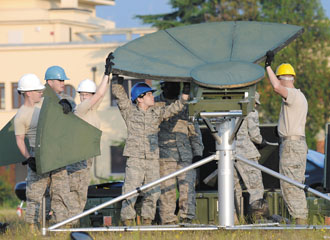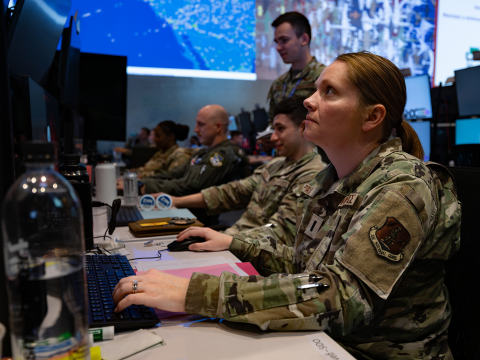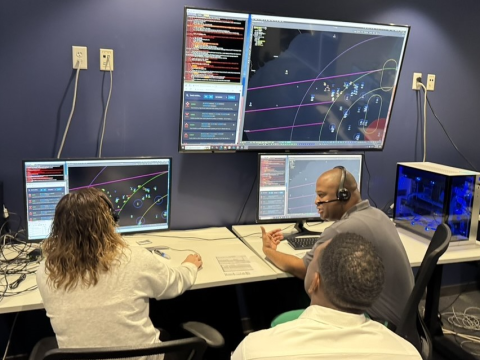Military Branch Undertakes Massive Troop Conversion
 |
Airmen from the 1st Combat Communications Squadron at Ramstein Air Base, Germany, set up satellite equipment during a training exercise at Aviano Air Base, Italy. The training was preparation for the largest Air Force Specialty Code (AFSC) transformation in the history of Air Force communications. |
The U.S. Air Force has completed its largest-ever communications specialty code transformation and one of its largest-ever personnel changes. Tens of thousands of enlisted airmen, as well as thousands of civilians, migrated from traditional communications job codes to new cyber job codes. The change creates the emphasis necessary for success in the cyberspace domain and will affect all Air Force operations.
Approximately 43,000 total force enlisted airmen and 8,800 civilian personnel saw their Air Force Specialty Codes (AFSCs) alter from communications to cyberspace support on November 1, 2009. Chief Master Sgt. Kevin Call, USAF, the Air Force knowledge operations management and postal career field manager, says that because of the enormity of the conversions, the airmen all were transitioned to a primary cyber path on that date.
The majority of personnel will remain in that AFSC, but some later migrated to more specialized codes within the cyberspace support field because of their unique skill sets and their locations’ missions. The Air Force completed that second transfer on December 1, 2009. The personnel transferred from 15 communications AFSCs into 11 cyberspace support subspecialties. “This effectively absorbed the existing Air Force communications and information work force into the cyberspace support and operations work force,” Chief Call explains.
The new cyberspace support career field jobs are the 3DXXX family. The 11 subspecialty AFSCs, by description, are: knowledge operations management; cyber systems operations; cyber surety; computer systems programming; client systems; cyber transport systems; radio frequency transmission systems; spectrum operations; ground radar systems; airfield systems; and cable and antenna systems.
Airmen in the communications career fields already were performing most of the new AFSC capabilities, which made them the perfect fit to take part in this force transformation, Chief Call says. Some airmen are performing the same duties under the new AFSCs as they were under the former codes. Others have transitioned into jobs created by combining similar skill sets of the legacy communications and information AFSCs. The cyber surety and client systems job codes both are entirely new capabilities created under the change. The Air Force chose personnel for the codes based on their training, expertise and mission requirements. Transition to the new job codes was mandatory for personnel.
As part of the transition, the Air Force eliminated two communications AFSCs—radio communications systems and communications-computer systems planning and implementation. Chief Call explains that technological advances resulted in the radio communications systems AFSC evolving to the point where the Air Force rolled the capability into other cyberspace support codes. He adds that the communications-computer systems planning and implementation of the AFSCs’ core capabilities and competencies will be ingrained in all cyberspace support airmen, regardless of job code.
Under the specialty code transformation, airmen were not required to change location assignment. Rather, they were converted to the AFSC that each specific position required. Chief Call explains that cyberspace support airmen work at almost every location that hosts Air Force personnel. Every Air Force installation around the world was affected by the transformation.
According to the chief, the transition went remarkably well. In addition to efforts from the Air Force communications and information community to execute the transition, other personnel from the service branch also were involved. These include members of the
The personnel transformation reflects how significant cyberspace is to all Air Force operations and missions as well as the importance the Air Force places on the domain. “Defending and controlling our network’s operational capabilities (cyberspace) are critical to all Air Force operations,” Chief Call states. “Just like today’s commercial businesses, without communications you have to resort to manual methods of getting things done, and we’re not very accustomed to that anymore. We rely on communications so heavily today … it’s critical we keep our networks operational 24/7/365. We are training our cyberspace support airmen to better sustain and protect the Air Force network so we can count on round-the-clock operational capabilities.”
The Air Force also has introduced its “Rise of the Cyber Wingman” philosophy in another effort to succeed in the cyber domain. The philosophy outlines 10 principles for all Air Force personnel to follow. The new AFSCs take cyberoperations even further. “The ‘Rise of the Cyber Wingman’ guiding principles are for every airman in the Air Force to adhere to,” Chief Call states. “The [cyberspace support] AFSCs are more specialized in cyberspace capabilities.”
The impetus for this massive personnel conversion came in April 2008 when Secretary of the Air Force Michael Wynne signed the Air Force Roadmap for the Development of Cyberspace Professionals. “This established the core competencies of cyberspace operations as establishing, controlling and leveraging the cyber domain,” Chief Call says. The roadmap also established the new officer and enlisted cyber support AFSCs. Officers are scheduled to convert to cyberspace support codes in the fall.
Technological advances and a smaller work force drove the requirement for the new job assignments. “The most important result of this change is creating the focus and attention required to control and leverage the cyberspace domain,” the chief states. He adds that, “Airmen will be better trained on their core capabilities and will better understand their role in operating in and protecting the cyberspace domain and how their mission directly supports the warfighter.”
The new skill sets acquired by the cyberspace support airmen are operationally focused so they will affect every operation in the Air Force. This ranges from ensuring radar or satellite capabilities are operational to programming software to provide senior leadership with a real-time picture of the mission more effectively. The goal of the transformation, according to Chief Call, is to produce professional airmen with the ability to establish, control and leverage the cyberspace domain. “They will operate across a broad range of critical infrastructures, warfighting systems and technologies and employ capabilities from airborne platforms and through space systems, from in-garrison units and from forward-deployed units,” he says.
The Air Force expects the force transformation to enhance operational capability within the growing cyberspace support and cyberspace operations environment. The transitioned airmen have the tasking to offer better tools to provide data, information and knowledge more quickly and through more secure means than in the past. “This will result in more timely and accurate decision making,” Chief Call says.
The force transformation will have minimal effect on future personnel placement and training. Chief Call says that for almost all the new AFSCs, the same assignment processes will remain in place. To obtain certain capabilities skills, airmen will be sent to specialized training beyond what they receive in the initial skills courses. After completing the schooling, they will be placed strategically in a cyberoperations unit. All personnel begin their cyberspace training with a 10- or 43-day information technology fundamentals course. The coursework, according to Chief Call, explains cyberspace operations as well as provides training on cybersecurity and networking. Airmen in certain AFSCs will continue to a 33-day second phase of the course to learn more electronic principles.
The chief adds that because the majority of airmen already were performing the new AFSC competencies, most training will be on-the-job. “Airmen are required to be trained on any new core tasks in their new [cyberspace support] education and training plan,” he says. “But, there is specialized training that will require supplemental training at a technical training school or will require a mobile training team to be dispatched to certain locations.”
In one preparation exercise, personnel from the 1st Combat Communications Squadron at Ramstein Air Base,
WEB RESOURCES
Aviano Air Base: www.aviano.af.mil
Ramstein Air Base: www.ramstein.af.mil
“Rise of the Cyber Wingman” Guiding Principles: www.af.mil/news/story.asp?id=123177473



Comments